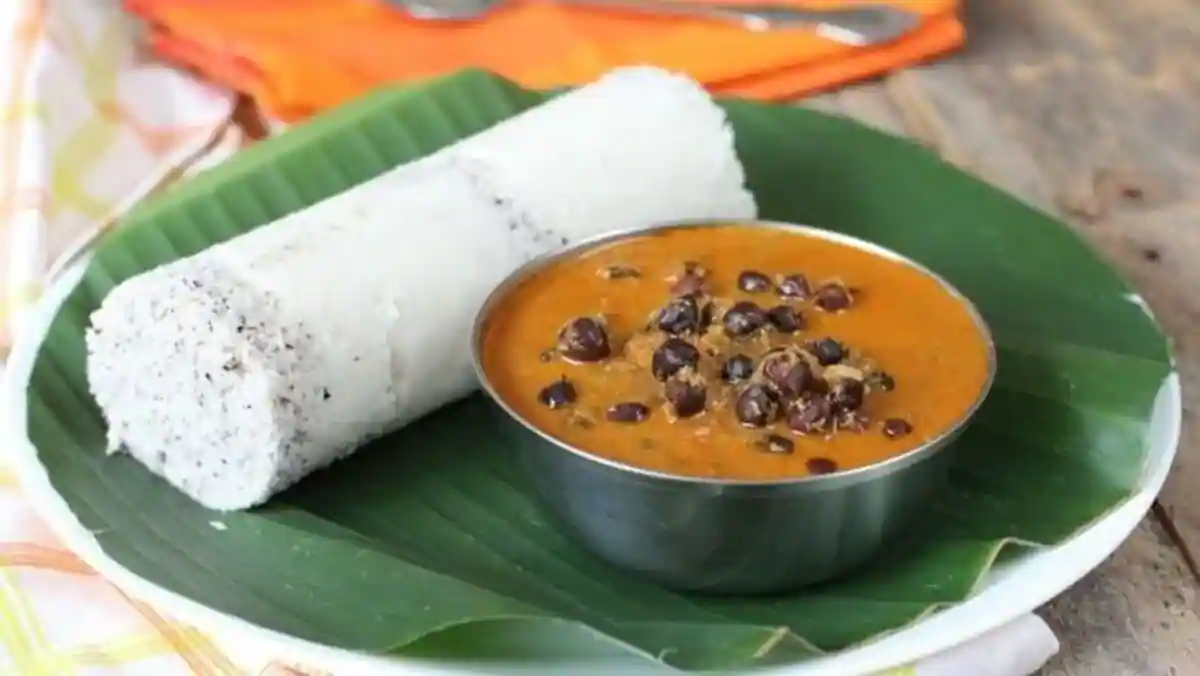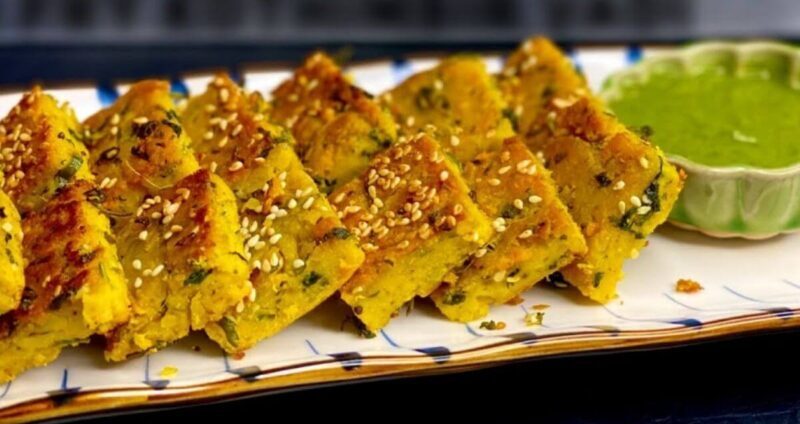Alu Vadi Recipe, a popular Maharashtrian dish, features stuffed and rolled colocasia leaves, known as taro in English. Contrary to its name, it has no association with potatoes (aloo in Hindi). This classic snack is also recognized as Patra Recipe in Gujarati cuisine and Pathrode in coastal regions of Karnataka, South India. Alu Vadi stands out as a gluten-free, low-fat, and healthy snack choice.
The dish begins with the tender colocasia leaves being layered with a sweet, sour, and spiced gram flour (besan) paste. These leaves are then stacked, rolled, and steamed until cooked. The steamed rolls are sliced into thick spirals and tempered with basic spices and curry leaves, offering a burst of flavors and textures. Optionally, the spirals can be deep-fried or pan-fried for a crispy finish. Finally, they are garnished with fresh grated coconut and chopped coriander leaves.
Despite its intricate appearance, Alu Vadi is not overly difficult to prepare. Fresh, non-itchy colocasia leaves are essential, as the presence of calcium oxalate crystals can cause irritation. Additionally, spinach leaves can be used as a substitute for colocasia leaves to create a delicious variation. Alu Vadi is especially popular during the monsoon season in India, making it a perfect addition to festivities like Ganesh Chaturthi.
How to Make Alu Vadi Recipe
Prepare the Batter
- In a mixing bowl, combine the following ingredients for the batter:
- 2.5 cups gram flour (besan)
- 1 inch ginger + 1 to 2 green chilies, crushed into a paste using a mortar and pestle
- 1 teaspoon coriander powder
- ½ teaspoon red chili powder
- ½ teaspoon turmeric powder
- 1 teaspoon cumin powder
- ½ to 1 teaspoon oil (optional)
- Salt to taste
Method: Alu Vadi Recipe
- Add 3 to 4 tablespoons of jaggery powder and tamarind pulp to the bowl.
- To make the tamarind pulp, soak 1.5 tablespoons of seedless tamarind in ¼ cup hot water for 20 minutes. Then, squeeze the pulp from the soaked tamarind in the water and add it to the bowl.
- Mix the ingredients thoroughly to form a thick batter or paste, ensuring there are no lumps. Set the batter aside.
- If the batter appears too thick, you can add a small amount of water to achieve the desired consistency.
Prepare Colocasia Leaves:
- Rinse 20 medium to large-sized colocasia leaves thoroughly with water and pat them dry using a kitchen napkin.
- Trim the stalk from the base of each leaf.
- Place each leaf with the veins facing upward and carefully slice the middle vein down the center without tearing the leaf. Remove any other thick veins from the sides as well. Ensure all the leaves are prepared in this manner.
Tip: Instead of using a knife, you can gently roll a rolling pin over the leaves to flatten the veins without cutting through the leaf. Adjust the pressure based on the thickness of the veins.
Assemble and Make Pathrode Rolls:
- Place each colocasia leaf with the vein sides facing downwards and the tip pointing towards you. Apply a layer of the prepared gram flour batter on the entire surface of the leaf.
- Position another leaf on top, aligning its tip in the opposite direction of the first leaf. This arrangement helps in rolling the leaves smoothly.
- Apply the batter evenly over the second leaf, covering its entire surface.
- Ensure that the leaf is completely coated with the gram flour batter.
- Place a third leaf on top, again with the tip facing towards you, and apply the batter evenly.
- Repeat this process for all 10 leaves, layering them one over the other.
- Once all the leaves are layered, fold one side of the stack as shown in the picture.
- Apply batter to the folded side and then fold from the opposite side as well. Make sure to apply batter to both folded sides.
- Begin tightly rolling the stack of leaves, applying batter with each fold to seal them together.
- Continue rolling until all the leaves are tightly packed together in a roll.
Steam Alu Vadi:
- After preparing 2 rolls using 2 batches of 20 leaves, with each roll containing 10 leaves, place these rolls in a greased steamer pan.
- Steam them for 20 to 25 minutes in a steamer or pressure cooker without the vent weight or whistle.
- Once steamed, the leaves and the batter will be thoroughly cooked, and the rolls will become firm.
- When warm or cooled, slice the steamed rolls into ½ inch thick spirals.
Make Tempering:
- Heat 2 tablespoons of oil in a pan or kadai (wok) over low to medium-low heat.
- Add 1 tbsp of mustard seeds and let them crackle. Then add 10 to 12 curry leaves, ¼ teaspoon of asafoetida (hing), and 2 to 3 teaspoons of white sesame seeds. Fry for a few seconds until the sesame seeds crackle and the curry leaves become crisp.
- Add the sliced colocasia rolls and sauté on low heat for a few minutes, turning them as needed, until they start to look crisp and golden.
- Turn off the heat. Finally, add ¼ cup of grated fresh coconut and 2 tablespoons of chopped coriander leaves. Gently stir and mix.
- Serve the Alu Vadi or Patra hot or warm. You can also garnish the Pathrode with coconut and coriander leaves instead of mixing them with the rolls.
Conclusion:
Alu Vadi Recipe, with its stuffed and rolled colocasia leaves, offers a delightful combination of flavors and textures. Despite its seemingly complex preparation, it is a rewarding dish that can be enjoyed by all, especially during festive occasions and the monsoon season. With its gluten-free and low-fat nature, Alu Vadi stands out as a healthy snack option in Indian cuisine.
FAQs Alu Vadi Recipe
What is Alu Vadi?
Alu Vadi, a popular Maharashtrian dish, consists of stuffed and rolled colocasia leaves, also known as taro in English. Despite its name, it does not contain potatoes (aloo in Hindi). This gluten-free snack is also recognized as Patra Recipe in Gujarati cuisine and Pathrode in coastal regions of Karnataka, South India.
How is Alu Vadi prepared?
Alu Vadi preparation involves layering tender colocasia leaves with a sweet, sour, and spiced gram flour (besan) paste. The stacked leaves are then rolled tightly, steamed until cooked, and sliced into spirals. These spirals are then tempered with basic spices and garnished with fresh grated coconut and chopped coriander leaves.
Is Alu Vadi difficult to make?
Despite its intricate appearance, Alu Vadi is not overly difficult to prepare. Fresh, non-itchy colocasia leaves are essential, and spinach leaves can be used as a substitute. The key steps involve layering, rolling, steaming, slicing, and tempering the rolls.
Can Alu Vadi be customized?
Yes, Alu Vadi can be customized according to personal preferences. The level of sweetness, sourness, and spiciness in the gram flour batter can be adjusted. Additionally, the tempering spices can be varied to suit individual tastes.
When is Alu Vadi typically enjoyed?
Alu Vadi is especially popular during the monsoon season in India and is often prepared during festivals like Ganesh Chaturthi. It is enjoyed as a savory snack or appetizer, served hot or warm.


